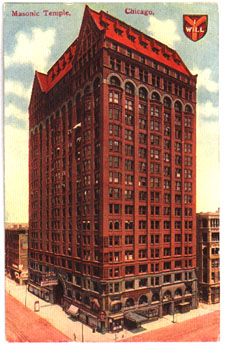Masonic Temple
Chicago, IL
Opus 2504-2513

Analysis:
8 Open Diapason (Leathered) 73
8 Viol d'Orchestre 73
16 Bourdon 97
8 Gross Flute (TC) 61
8 Vox Humana 73
Great or Accompaniment
8 Open Diapason
8 Open Diapason (2nd Touch)
8 Viole d'Orchestre
8 Clarabella Flute
4 Clarabella Flute
8 Vox Humana
Tambourine
Castanets
Tom-Tom
Wood Blocks
Bird Whistle
Gt to Gt 4
Swell or Solo
16 Bourdon
8 Principal
8 Concert Flute
8 Tibia
8 Violin
4 Flute
2 2/3 Nazard
2 Piccolo
1 3/5 Tierce
8 Vox Humana
Solo to Solo 16-4
Pedal
16 Sub Bass
8 Open Diapason
8 Cello
8 Flute
Tremolo (entire organ)
Chime (Middle C)
8 Open Diapason (Leathered) 73
8 Viol d'Orchestre 73
16 Bourdon 97
8 Gross Flute (TC) 61
8 Vox Humana 73
Great or Accompaniment
8 Open Diapason
8 Open Diapason (2nd Touch)
8 Viole d'Orchestre
8 Clarabella Flute
4 Clarabella Flute
8 Vox Humana
Tambourine
Castanets
Tom-Tom
Wood Blocks
Bird Whistle
Gt to Gt 4
Swell or Solo
16 Bourdon
8 Principal
8 Concert Flute
8 Tibia
8 Violin
4 Flute
2 2/3 Nazard
2 Piccolo
1 3/5 Tierce
8 Vox Humana
Solo to Solo 16-4
Pedal
16 Sub Bass
8 Open Diapason
8 Cello
8 Flute
Tremolo (entire organ)
Chime (Middle C)
Console to be special circular
theatre type
with stop keys to operate stops.
Notes
with stop keys to operate stops.
Notes
The
picture (above) is of the previous Masonic Temple which was
located at the northeast corner of State and Randolph streets.
In 1926 the Masons moved to a new and larger building on Randolph Street, 1/2 block west of the one pictured in the postcard.
(The old building was demolished in the late 1930's). The new building was a joint venture between the Masonic Fraternity
and the Balaban & Katz theatre chain and includes retail stores at street level, multiple floors of rental office space and
is anchored by the Oriental Theatre. The Masonic lodge halls were ingeniously located on several upper floors
at the rear of the building directly above the Oriental Theatre auditorium. The 10 smaller adjoining lodge halls containing
identical Estey organs numbered 2504 thru 2513 were laid out in a parallel plan accessible from a common lodge foyer as
well as common backstage areas. The organ chambers were also located side by side to each other on an upper level
above the stages/podiums of the lodge halls, allowing organ technicians to walk from one chamber to the next for maintenance
without having to enter successive lodge halls. The three larger instruments were located in the larger lodge halls
on the floors above; the largest hall was often rented out as a ballroom; it contained Estey opus 2516.
I played several of these instruments during the 1960's while the lodge halls were still in use; the Masons had leased
out one of the larger halls as a Fred Astair dance studio. By the late 1960's, faced with declining membership,
the Masons closed all the lodge halls in the building and the organs were sold to a variety of theatre organ hobbyists.
In 1926 the Masons moved to a new and larger building on Randolph Street, 1/2 block west of the one pictured in the postcard.
(The old building was demolished in the late 1930's). The new building was a joint venture between the Masonic Fraternity
and the Balaban & Katz theatre chain and includes retail stores at street level, multiple floors of rental office space and
is anchored by the Oriental Theatre. The Masonic lodge halls were ingeniously located on several upper floors
at the rear of the building directly above the Oriental Theatre auditorium. The 10 smaller adjoining lodge halls containing
identical Estey organs numbered 2504 thru 2513 were laid out in a parallel plan accessible from a common lodge foyer as
well as common backstage areas. The organ chambers were also located side by side to each other on an upper level
above the stages/podiums of the lodge halls, allowing organ technicians to walk from one chamber to the next for maintenance
without having to enter successive lodge halls. The three larger instruments were located in the larger lodge halls
on the floors above; the largest hall was often rented out as a ballroom; it contained Estey opus 2516.
I played several of these instruments during the 1960's while the lodge halls were still in use; the Masons had leased
out one of the larger halls as a Fred Astair dance studio. By the late 1960's, faced with declining membership,
the Masons closed all the lodge halls in the building and the organs were sold to a variety of theatre organ hobbyists.
-John R. Grune
Sources
Estey Opus List
Shop Order
John R. Grune
Estey Opus List
Shop Order
John R. Grune